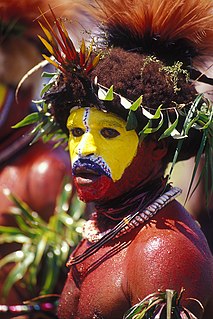Related Research Articles

Pandanus is a genus of monocots with some 750 accepted species. They are palm-like, dioecious trees and shrubs native to the Old World tropics and subtropics. The greatest number of species are found in Madagascar and Malaysia. Common names include pandan, screw palm, and screw pine. They are classified in the order Pandanales, family Pandanaceae.
Kobon is a language of Papua New Guinea. It has somewhere around 90–120 verbs.
Kuman is a language of Chimbu Province, Papua New Guinea. In 1994, it was estimated that 80,000 people spoke Kuman, 10,000 of them monolinguals; in the 2000 census, 115,000 were reported, with few monolinguals.
The Burmeso language – also known as Taurap – is spoken by some 300 people in Burmeso village along the mid Mamberamo River in Mamberamo Tengah subdistrict, Mamberamo Raya Regency, Papua province, Indonesia. It is surrounded by the Kwerba languages to the north, the Lakes Plain languages to the south, and the East Cenderawasih Bay languages to the west.

Huli is a Tari language spoken by the Huli people of the Hela Province of Papua New Guinea. It has a pentadecimal (base-15) numeral system: ngui means 15, ngui ki means 15×2 = 30, and ngui ngui means 15×15 = 225.
Adzera is an Austronesian language spoken by about 30,000 people in Morobe Province, Papua New Guinea.
The eastern white-eared giant rat is a species of rodent in the family Muridae. It is found only in Papua New Guinea.
Rothschild's woolly rat is a species of rodent in the family Muridae. It is found on the island of New Guinea: both in the West Papua region of Indonesia and Papua New Guinea.

Fasu, also known as Namo Me, is one of the Kutubuan languages of New Guinea.

The Chimbu–Wahgi languages are a language family sometimes included in the Trans–New Guinea proposal.
Momuna (Momina), also known as Somahai, is a Papuan language spoken in the highlands of Papua province, Indonesia.

Wiru or Witu is the language spoken by the Wiru people of Ialibu-Pangia District of the Southern Highlands Province of Papua New Guinea.

Pawaia, also known as Sira, Tudahwe, Yasa, is a Papuan language that forms a tentative independent branch of the Trans–New Guinea family in the classification of Malcolm Ross (2005).
Foi, also known as Foe or Mubi River, is one of the two East Kutubuan languages of the Trans-New Guinea family spoken along Lake Kutubu and Mubi River, located in the Southern Highlands Province of Papua New Guinea. Dialects of Foi are Ifigi, Kafa, Kutubu, Mubi. A Swadesh list for the Foi language was documented by The Rosetta Project in 2010. The estimated number of Foi speakers as of 2015 is between 6,000 and 8,000.

Yagaria is a Papuan language spoken in the Goroka District of Eastern Highlands Province, Papua New Guinea. Named dialects are Kami-Kulaka, Move, Ologuti, Dagenava, Kamate, Hira, Hua (Huva) and Kotom. Yagaria has a total number of 21,116 speakers.
Angal, or Mendi, is an Engan language complex of the Southern Highlands province of Papua New Guinea.
Kewa is an Engan language complex of the Southern Highlands province of Papua New Guinea. A dictionary of the western dialect of Kewa has been compiled by Franklin & Franklin (1978).

A pandanus language is an elaborate avoidance language among several of the peoples of the eastern New Guinea Highlands, used when collecting Pandanus nuts.
Tembagla, also known as Bo-Ung (Mbo-Ung), is one of the languages spoken in the Southern Highlands province of Papua New Guinea. Geographically the people are Kaugel, but their language appears to be closer to the related Medlpa.

The karuka is a species of tree in the family Pandanaceae and an important regional food crop in New Guinea. The nuts are more nutritious than coconuts, and are so popular that villagers in the highlands will move their entire households closer to trees for the harvest season.
References
- ↑ Ibo Ugu (Imbo Ungu) at Ethnologue (18th ed., 2015)
Ubu Ugu (Umbu Ungu) at Ethnologue (18th ed., 2015) - ↑ "Imbongu Ethnologue Entry". Ethnologue: Languages of the World, Sixteenth edition. SIL International. Retrieved 24 January 2012.
- ↑ "The Bible in Imbongu language". worldbibles.org. Retrieved 24 January 2012.
- ↑ Franklin, Karl J.; Stefaniw, Roman (1992). "The 'Pandanus Languages' of the Southern Highlands Province, Papua New Guinea - a further report" (PDF). In Dutton, Tom (ed.). Culture change, language change - case studies from Melanesia. Pacific Linguistics. C-120. Canberra: Department of Linguistics Research School of Pacific Studies THE AUSTRALIAN NATIONAL UNIVERSITY. pp. 1–6. doi:10.15144/PL-C120.1. ISBN 978-0858834118. ISSN 0078-7558. OCLC 260177442 . Retrieved 25 October 2018.